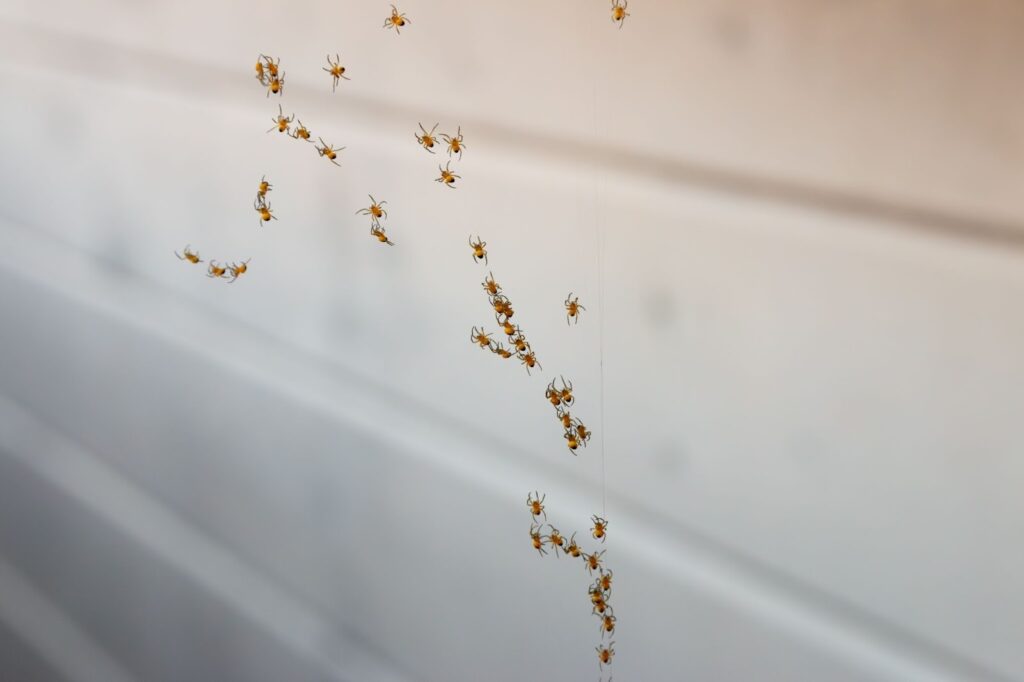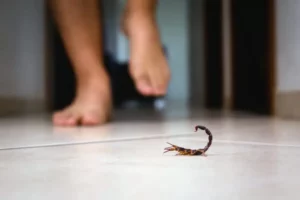Home / Blog / Spiders / How to Identify & Get Rid of Spider Egg Sacs
How to Identify & Get Rid of Spider Egg Sacs
-Published on October 13, 2025
-Updated on November 6, 2025

Finding spider egg sacs around your home is unsettling, and many people aren’t sure what to do about it. While it’s true that spiders help to keep other smaller insects around your home at bay, having a “sack” of spider eggs hatch indoors can lead to a problematic infestation if not handled quickly and properly.
Key Takeaways:
- Spot them early — Spider egg sacs are small, white, and often hidden in corners or behind furniture.
- Know the risks — Some sacs may belong to dangerous spiders like Black Widows.
- Don’t crush — Crushing can release spiderlings; use a vacuum or bleach instead.
- Empty sac = hatched — A deflated sac means spiders have already emerged.
- Call Hawx Pest Control for Spider Control Services
What do spider egg sacs look like?
Let’s clarify how to identify spider egg sacs.
Generally speaking, they look like a small, whitish, fuzzy bubble attached to a wall, furniture, or corner. They can come in different sizes, shapes, and colors (though usually they are white or cream-colored, since they are loosely woven from the spider’s silk). Most of the time, they’re round or oblong. Some are smooth, but some can have little spikes or bumps. Usually, egg sacs are about as big as the spider that made it.
The sacs are made to protect the eggs from predators. But once you know how to spot one, a sac is no match for your pest control measures, both DIY and professional.
One caveat: it’s also important to determine if you’re dealing with a spider egg sac or a Yellow Sac Spider. This type of spider builds small silk nests or sacs that they rest in during the day. They are typically translucent and a little harder to notice, sometimes blending in with their surroundings like walls and ceilings. Their bites can be painful to humans, so if you think you’re seeing a yellow sac spider’s home and not just a generic spider sac, be careful when handling its disposal.
Where do spiders lay their egg sacs?
Spiders lay their egg sacs in a variety of places. Outside, you might find them tucked into the spider’s web, under leaves, stuck to tree branches, or hidden away in a burrow. Some spiders go the extra mile and actually carry their egg sacs with them, keeping them close for added protection. If you notice an egg sac on a spider, take measures to dispose of it in order to avoid an eventual infestation of its offspring.
Inside, spider egg sacs can be found attached to walls, behind furniture, and in the quiet corners of your house. The spider will attach its egg sac anywhere that seems like a safe spot where no other predators can disturb the eggs
Are they dangerous? Will hundreds of spiders be hatching in my home?
A spider’s egg sac is just a cluster of germinating eggs. If you notice and eliminate it early, your home’s in the clear.
And to be clear, even if they did hatch, most spiders are not dangerous to humans. If you find an empty spider egg sac in your home, don’t panic. Just keep an eye out for spiders, vacuum them up when possible, or call for professional pest control help if you want complete spider-free peace of mind.
Regarding dangerous spiders to keep an eye out for—and subsequent spider egg sacs to be worried about what’s inside—be careful when handling anything that looks like it belongs to a Brown Recluse Spider and Black Widow Spider. For these, read on to learn more about when to call us to safely remove their egg sacs.
What if a spider egg sac is empty?
A spider egg sac is only empty once all the baby spiders—which are called spiderlings—have hatched and left the sac. A full sac will be fully attached to its base and seem full. If you’re trying to discern whether an egg sac is empty, looks for these clues:
- Since the sacs are made out of spider’s silk, they’re very lightweight, so an empty one will move around easily in the wind or when lightly nudged.
- It would seems loose and movable.
- Another sign of an empty spider egg sac is its shape: once the spiderlings have crawled out, the sac usually loses its neat, round shape.
- An empty sac might have little openings or look a bit deflated.
If you’ve discovered an empty spider egg sac, now just watch out for spiders. Vacuum them up and dispose of them as you see fit, or call Hawx for help getting your home spider-free.
How do you get rid of spider egg sacs?
You probably want to remove spider egg sacs before baby spiders hatch in your home.
- Vacuum: Luckily, most of the time, getting rid of them is almost as easy as clearing out spider webs. One quick and clean way is to use a vacuum cleaner hose. Simply suck up the egg sac and toss the vacuum bag in the outdoor trash. Make sure your vacuum has a sealed, disposable bag, as tiny spiderlings can escape small spaces.
- Tweezer + Bleach: If you can’t reach a sac with a vacuum hose, or if you aren’t sure that your vacuum bag will keep potential spiderlings inside, carefully use tweezers to remove the sac and then dispose of it by submerging it in bleach or alcohol.
- Watch out for certain species: If you think the sac belongs to a more dangerous spider like a Brown Recluse or a Black Widow, use gloves, wear long sleeves and pants, and wear closed-toe shoes when preparing to vacuum away the sac. It’s best to use tools like tweezers to collect them safely. Once removed, place the sacs in sealed jars or bags if you intend to identify or destroy them. Avoid using a vacuum unless it has a sealed, disposable bag, as tiny spiderlings can escape small spaces. To destroy these egg sacs safely, submerge them in rubbing alcohol or a bleach solution, or freeze them in a sealed bag for at least 48 hours. Never crush these egg sacs indoors, as this can cause mature spiderlings to be released.
What happens if you crush a spider egg sac?
Our advice: Avoid crushing a spider sac indoors.
Even if you crush a sac when the eggs are still early in development (i.e., the spiders inside won’t hatch and run away), while you may kill the embryos, the act can leave biological residue which attracts ants or other scavengers.
Meanwhile, if the sac is close to hatching, crushing and thereby possibly opening it can accidentally let any mature spiderlings out. They are tiny, fast, and capable of scattering quickly (which is probably what you’re trying to avoid). They’re probably not venomous threats, but they can crawl into hidden areas, creating a future infestation.
And some spider species, like dangerous Black Widows, have tougher sac membranes, so crushing may only partially rupture the sac, allowing its spiderlings to escape rather than be destroyed.
Call for professional removal if you’re dealing with an infestation. When tackling any spider problem, it’s always a good idea to call Hawx Pest Control—we can help you get it under total control.
Related Articles
Visit our blog to learn more.
→






